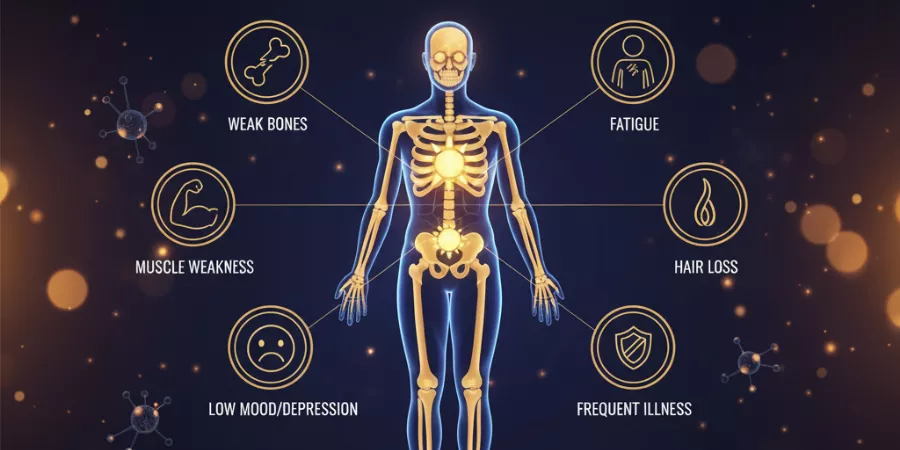The thing is many adults live with low vitamin D levels and do not realise it. Studies show that around 24 % of adults in the United States have vitamin D deficiency in adults when defined as 25-hydroxyvitamin D levels below about 20 ng/mL.
Around the world, the prevalence is even higher. When you carry that fact into everyday life, it means a lot of people may ignore or misinterpret physical signs that truly matter. Recognising the signs and symptoms of vitamin D deficiency in adults becomes useful not just for health professionals but for each person who wants to stay well.
Why Signs and Symptoms of Vitamin D Deficiency Matter
When the body lacks sufficient vitamin D, it cannot absorb calcium or phosphorus effectively. Poor mineral absorption leads to structural stress on bones and muscles before obvious disease appears. What this really means is that early symptoms, some vague, some subtle, can serve as early alerts.
If those alerts are ignored, they may evolve into more serious problems like bone softening (osteomalacia) or increased fracture risk. So being aware of signs and symptoms of vitamin D deficiency in adults helps you act rather than simply react.
Bone-Related Signs of Vitamin D Deficiency in Adults
One of the clearest arenas where the deficiency shows is vitamin D and bone health. Adults may feel persistent bone pain or ache in places like the lower back, hips or legs. That pain arises because bones are not receiving enough minerals to maintain strength and resilience. If you recall a friend or family member complaining of “an ache that will not go away”, this could be relevant.
In more advanced cases, the term osteomalacia comes in, meaning that bones become softer and less well-mineralised. One might see vitamin D deficiency symptoms such as fractures that happen more easily than expected or delayed healing after a break. That said, recognising these symptoms early means you can seek testing, adjust diet or work with a health provider rather than wait for a fracture to occur.
Muscle and Movement-Related Signs of Vitamin D Deficiency
Bones are only part of the picture. Muscles and movement tell another part. Muscle weakness, especially in the hips or thighs, may show up as difficulty rising from a chair, climbing stairs or a general feeling of heaviness. Muscle cramps, aches or twitches can also be indicators. Imagine yourself moving more slowly, feeling your limbs complain when they did not before, that may be your body signalling low vitamin D levels.
Another example: fatigue that seems outsized compared to what you expect. A narrative review found links between vitamin D deficiency fatigue and mood changes through mechanisms involving inflammatory markers and neurotransmitter imbalance. In simple terms: when vitamin D is too low, your muscles might not perform as well and your movement may suffer long before you realise why.
Other Signals: Mood, Immunity and Everyday Weariness
The effects of vitamin D deficiency indicating a lack of vitamin D in adults don’t just affect the bones and muscles, but also include mood changes. Sadness or low mood are examples of feelings reported by some deficiency patients. The situation is not yet concluded for everyone, but the evidence has certainly reached a level where it demands attention.
Frequent illnesses or infections can be another indicator. The vitamin D and immune system is supported by vitamin D, and low vitamin D levels are linked to a greater susceptibility to the respiratory tract infections. Another sign could be a slower healing process for wounds. If you find that even small cuts or blisters take an unusually long time to heal, it is possible that vitamin D deficiency in adults is one of the factors involved.
An everyday example: You get out of bed, feel more exhausted than usually, your legs hurt, you are sick again, and you mistakenly think that it is just stress or a busy life. However, if this situation keeps happening, maybe what it really means is that your vitamin D deficiency symptoms are showing.
Who Runs a Higher Risk of Vitamin D Deficiency and Why
It helps to know who is at risk of vitamin D deficiency so you watch for the symptoms. Older adults have reduced skin ability to make vitamin D when exposed to sunlight. People with darker skin need more sun exposure to make the same vitamin D because pigment reduces ultraviolet-B penetration.
Conditions that reduce absorption, such as celiac disease, Crohn’s disease, bariatric surgery, also increase risk. Obesity is another factor: more body fat may sequester vitamin D and make it less available. If you see someone older, darker-skinned, or with known gut issues who keeps complaining of aches and fatigue, you might start thinking about causes of vitamin D deficiency as part of the puzzle.
What to Do if You Recognise Signs and Symptoms of Vitamin D Deficiency
Recognising what are the signs of vitamin D deficiency in adults is the first step. The next step requires action. A healthcare provider can order a vitamin D deficiency test measuring 25-hydroxyvitamin D (25(OH)D) which gives a reliable indication of status. If the result shows low vitamin D levels, the provider may recommend increased sun exposure (while managing skin-cancer risk), dietary changes and/or supplementation.
Common recommendations for healthy adults centre around 600 to 800 IU daily, though higher doses may be needed in certain cases. Choosing foods rich in vitamin D for adults helps: fatty fish, fortified dairy or plant milks, and egg yolks. Pair that with safe sun time and you are covering the basics.
Also important: less waiting. If you have persistent symptoms, bone ache, muscle weakness, fatigue, and you match a high-risk profile, a conversation with your doctor makes sense. It is not about alarm. It is about awareness. Remember that initially early signs of low vitamin D could be very subtle; however, if you don’t act they could lead to greater risks compounded.
Takeaway
Therefore, the main point is that you do not need to have very serious or clear-cut symptoms in order to think about vitamin D deficiency in adults. A vague ache, unusual fatigue or mood dip can count. Because the effects of vitamin D deficiency build quietly, being alert gives you a head start. When you recognise the signs and symptoms of vitamin D deficiency in adults, you gain the chance to act proactively. Discuss with your healthcare provider, check your vitamin D level, support vitamin D and bone health, protect your mood and immunity.
If you are unsure how to know if you have vitamin D deficiency, consider taking a vitamin D deficiency test to confirm. Based on the results, a doctor may suggest vitamin D deficiency treatment or guide you on how to treat vitamin D deficiency naturally through diet and sunlight exposure. Understanding the causes of vitamin D deficiency helps in prevention, while being aware of what are the signs of vitamin D deficiency in adults ensures early detection.
Whether you are experiencing early signs of low vitamin D or have been told you have vitamin D deficiency symptoms, the right vitamin D deficiency treatment can help. Staying alert to the effects of vitamin D deficiency on the vitamin D and immune system means better long-term health and tenacity.





